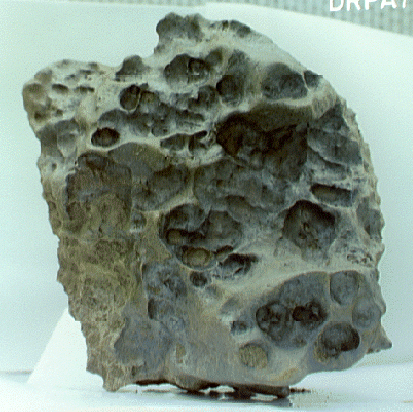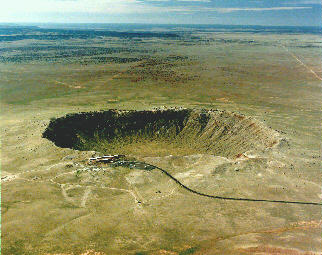 The Meteoroids and Meteorites
The Meteoroids and MeteoritesThe term meteor comes from the Greek meteoron, meaning phenomenon in the sky. It is used to describe the streak of light produced as matter in the solar system falls into Earth's atmosphere creating temporary incandescence resulting from atmospheric friction. This typically occurs at heights of 80 to 110 kilometers (50 to 68 miles) above Earth's surface. The term is also used loosely with the word meteoroid referring to the particle itself without relation to the phenomena it produces when entering the Earth's atmosphere. A meteoroid is matter revolving around the sun or any object in interplanetary space that is too small to be called an asteroid or a comet. Even smaller particles are called micro-meteoroids or cosmic dust grains, which includes any interstellar material that should happen to enter our solar system.
Why the interest in Meteoroids?
Radiometric dating has placed them at the
age of 4.55 billion years, which is the approximate age of the solar
system. They are considered pristine
samples of early solar system matter. It is also the only way we've
been able to collect material from Comets and Asteroids!
Craters and the time of Heavy Bombardment
Nearly every solid body we can study in our solar system shows evidence of
being hit with Meteorites, leaving behind craters. The young Solar System
had a lot more debris lying about (most have been cleared out now) and
impacts where frequent and powerful.
Near Earth Objects and Potentially Hazardous Asteroids
Today, astronomers are tracking hundreds of large objects, asteroids
or bits of asteroids or comets, which are known to intersect with the
Earth's orbit. There sizes are greater than 500 ft (city-block size)
and would create a crater about 1 mile across, similar to Meteor
Crater below. Such a collision is
expected every few hundred years and would destroy everything within a
hundred mile radius.
 1997 XF11 is perhaps the most scary of the NEAs,
with an estimated size of 1 km.
You can see it's orbital dynamics
HERE. Interesting dates: Oct 27, 2001 and Oct 18 through Oct 26, 2028.
For more on NEOs, see NASA's NEO website
Here.
1997 XF11 is perhaps the most scary of the NEAs,
with an estimated size of 1 km.
You can see it's orbital dynamics
HERE. Interesting dates: Oct 27, 2001 and Oct 18 through Oct 26, 2028.
For more on NEOs, see NASA's NEO website
Here.
The Age of our Solar System
A final important characteristic of our Solar System is the age. The Sun,
The Moon, Meteoroids and (the Earth to some extent), all the things we
can age in our solar system, all come out at about the same, 4.5 billion years!
The Earth is constantly changing its surface, so it's oldest rocks are
not quite this old.